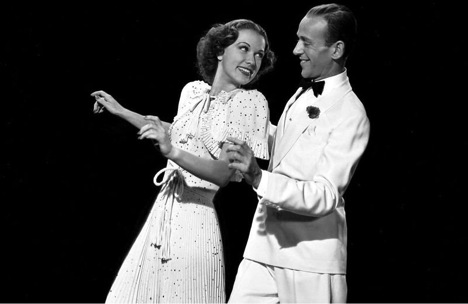[15] “Begin the Beguine”: Broadway Melody of 1940

And even the palms seem to be swaying...
—Cole Porter2
1
The feet these people dance upon are magical; just watch them fly. Nimbly in their tapping shoes, they slide, jump, rattle, drum, and skip. Fred and Eleanor, matching each other twitch and wiggle for twitch and wiggle: they pull apart to really tap, and reach for the gestures each uniquely does, and then extend beyond their limits to do more. When you tap-dance, the way these terpsichorean gods and goddesses did, you defy the laws of physics and gravity and bend the charm of music to the needs of your pounding slippers. In another movie altogether, you can see Eleanor toe-tapping messages in Morse Code to a curious Red Skelton, and in another, Fred, inspired by love, tap-dancing up a wall and across the ceiling.
for which an empty
shoe cries out, a metal plate
for banging on the floor
trains your toes and ankles so
they move exactly quickly
little girls and boys
scraping, heel, toe, brush and drag
keep getting better
till they can move so quickly
eyes and ears can’t see or hear it
who’s best at tapping
making lists, rattling off names
do the chug and pop
can’t always tell who’s following
and no one looks at their feet
2
Fred Astaire danced with many different partners in the movies—his sister Adele, to start, and then, in no particular order, Rita Hayworth, Judy Garland, Vera-Ellen, Joan Crawford, Cyd Charissse, Ginger Rogers—but he met his match in Eleanor Powell. While the others had all been actresses primarily (he had to teach Ginger Rogers how to tap-dance3), Eleanor Powell was a dancer all the way, first, last, and always. Besides, he could hardly spare the time to teach her; he was too busy keeping up. To look at this another way: they were equals dance-wise, Eleanor and Fred, and so you see them mainly dancing side by side, matching step and turn for step and turn, rat-a-tat-tat footwork for rat-a-tat-tat, gesture for gesture, alongside each other and not wrapped in each other’s arms. They’re more like girl-and-girl or boy-and-boy, than boy-and-girl. He tries hard to look straight ahead and not at her.
tap-dancing but so
competitive! match that if
you can! he steps out
performs the impossible
she does it even quicker
like call and response
he taps it out, rat-a-tat
she follows him there
differently, tat-a-rat-tat
does a quick twist at the end
so often with Fred
in the movies, the women
seem accessory
I see him twirling one out
sweeping another back in
3
An interesting question: what is the relation between life, in general a matter of movement with purpose, and dancing? A man and a woman sit and talk on a park bench, and when the music comes up, they start dancing. Do we assume dancing is an extension of life in general, but involving different movements (ornate and complicated) and bewildering purposes? We watch intently in hopes of grasping what the dancing means, but in the end it only means what we can see—the reach and possibilities of the human body alive and, in addition, motions that are at the same time deliberate but lacking in purpose.
they lean in and tap
oh, the chance that was wasted
their strange messages
each body trying to talk
just where the words have run out
I’m talking to you
phrases fail me. so I reach
for my dancing shoes
put my body through baffling
moves, tapping out messages
the shape of the dance
will always be
how absent letters
forced the twirling and jumping
dumb mouths chewing down the words
Bio: Charles D. Tarlton
